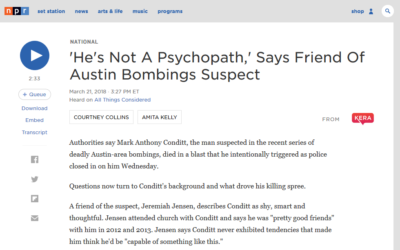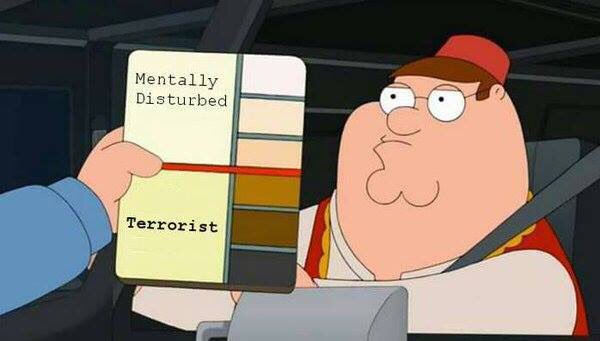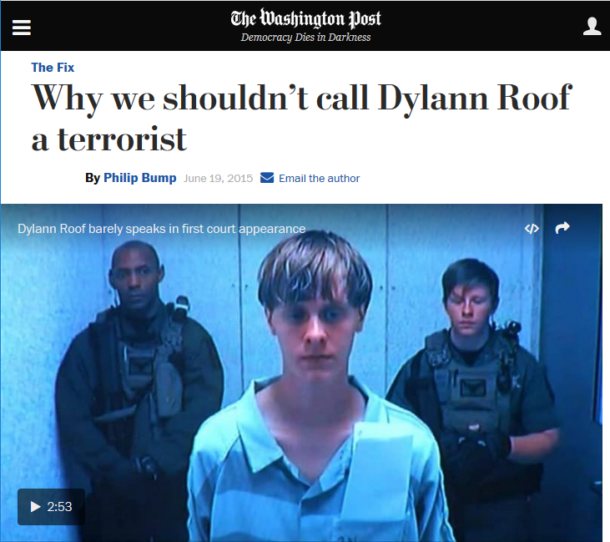Evidence of Violent Extremism of Little Interest When Killer Is White
ANGLO AMERICA, 2 Apr 2018
FAIR-Fairness & Accuracy In Reporting – TRANSCEND Media Service
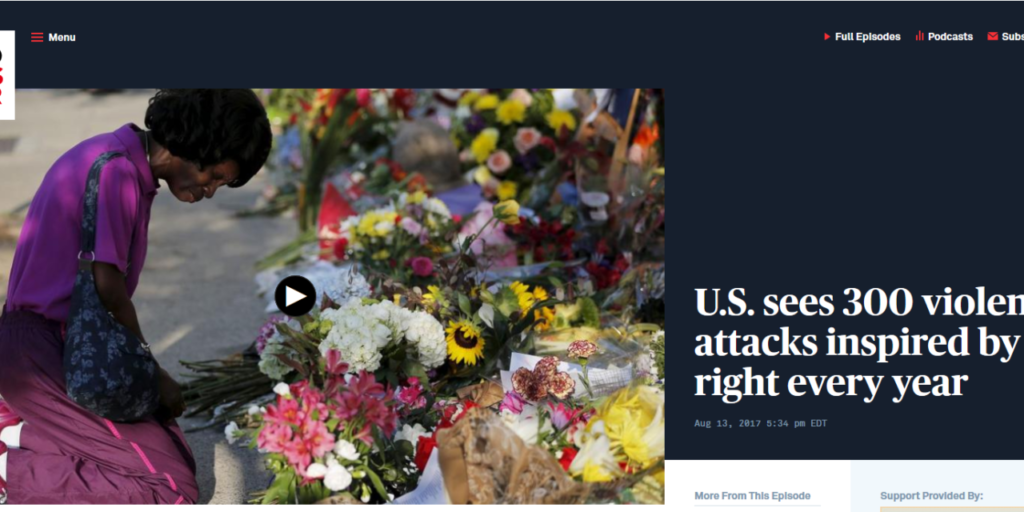
Far-right attacks are an almost daily occurrence–but of little interest to corporate news media.
(PBS NewsHour, 8/13/17).
29 Mar 2018 – Remember that Muslim mass murderer who belonged to an Islamic home-madrassa called INTIFADA, where knife-wielding Shari’a survivalists studied the Qur’an, guns and dangerous chemicals? And how the liberal media fawningly portrayed him as a misunderstood and under-loved young man otherwise full of promise?
You don’t, because that never happened. But have you heard about of the Christian Texas child-killer from an all-white sect who slaughtered the president of a homeowners’ association and a 17-year-old aspiring neurosurgeon, both on their own doorsteps and in front of their families? Both victims were African-Americans. This same murderer was a suicide bomber who blew himself up before police could arrest him and take him for a hamburger (as they did with Dylann Roof, the young white man who killed nine African-Americans at their church).
Had killer Mark Anthony Conditt been a brown Muslim, it’s hard to imagine corporate media not at least speculating that hateful ideology was a motive, and using (or at least debating the use of) the term “terrorism” to describe his crimes. But because Conditt was a white, conservative, homophobic Christian, corporate media and police alike have been—ahem—generous in their eulogies. Austin Police Chief Brian Manley even helpfully explained that Conditt never used the word “terrorism” in his 25-minute final recording, which was “the outcry of a very challenged young man talking about challenges in his own life.”
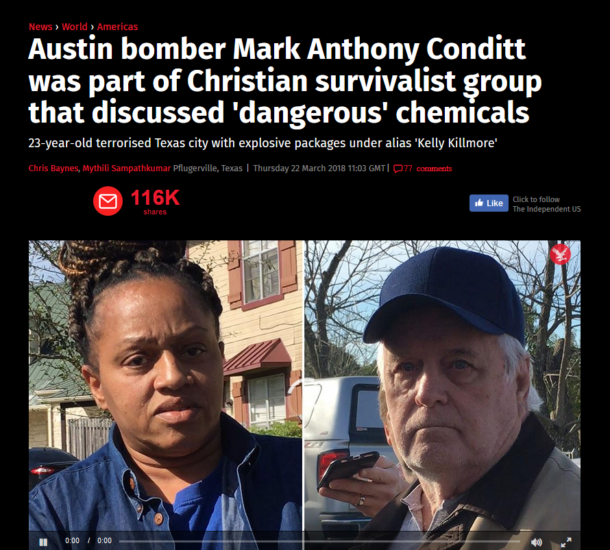
If a Muslim bomber had received religious-based weapons training (Independent, 3/22/18), that would likely be the lead fact in every report on them.
So what were Conditt’s views, and who “radicalized” him? Conditt blogged about his opposition to abortion, his support of the death penalty, his desire that gay marriage should be illegal, and that terrorists were bad. (As with Conditt’s defenders in corporate news and law enforcement, Conditt’s command of irony was nothing compared to his command of lethal explosives.)
According to the Independent (3/22/18), Conditt belonged to a homeschooling, Christian survivalist youth group called RIOT (Righteous Invasion Of Truth); while its Facebook group is inactive, the website for its sponsoring church (Grace House Clinton) shows photographs of an all-white congregation. RIOT taught the Bible and guns; Conditt’s sister Cassia Schultz explained that many RIOTers carried knives and “would discuss chemicals and how to mix them and which ones were dangerous.” She “could not recall” if they ever discussed making bombs.
If White Conditt were Brown Khalid, is it remotely conceivable that corporate news would have buried such a prima facie case of violent extremism? As Qasim Rashid tweeted, “White male privilege is detonating 5 bombs, executing 2 Black men, & media calls you a ‘quiet nerdy young man from a tight knit godly family.’”
Sympathy for the Devil
Some outlets managed to dramatize the whimsy behind capturing a Texan executioner, as with the New York Times headline (3/21/18) “Lucky Breaks, Video and Pink Gloves Led to Austin Bombing Suspect.” But to provide the most relevant psychological assessment of a serial murderer, NPR’s All Things Considered (3/21/18) helpfully sought Conditt’s friend Jeremiah Jensen. Despite not having seen Conditt for four years, Jensen explained that Conditt was “not a psychopath” (i.e., not a superficially charming, grandiosely self-important person utterly lacking in remorse for, say, bombing people at their homes).
Jensen, a former intern at an NPR station in Dallas, said the serial murderer was “shy, smart and thoughtful.” Despite being “pretty rough around the edges…dominant, pugnacious in nature,” he “attended church” and “started to soften” enough that Jensen “thought he was going to bloom into a productive person.” Conditt was “a deep thinker, very smart… funny and happy for the most part… [an] intense person and…hard to love but…a person. He was alive.”
Via NPR, Jensen reveals Conditt as shy, like many “homeschool kids,” while struggling to visit with non-family members. “I think that he might have isolated himself,” says Jensen, who wishes Conditt would have shared his pain to avoid such a grim end.
Fortunately for Conditt, his race and politics seem to have insulated him from being labelled a “snowflake” who refused to accept personal responsibility for his failures, and insulated his community from accusations of producing a super-predator who “doesn’t value life the way we do.” Conditt has posthumously embarrassed Jensen and Chief Manley, however; Reuters (3/24/18) reports that Conditt described himself as a psychopath in his final video testament (which Manley had already seen when he called the murderer “a very challenged young man”).
But surely NPR always doles out the sympathy when portraying murderers? Its story “Man Who Killed Officers Told Passersby: ‘Watch What I Am Going to Do’” (12/21/14) concerned Ismaaiyl Brinsley, who’d killed two police officers. NPR noted Brinsley’s online “postings and rants,” which showed “anger against the government,” Brinsley “burning a flag,” and discussions of Michael Brown and Eric Garner, “who were killed in encounters with police.” (Note the use of the passive voice.) While he had “15 prior arrests,” Brinsley showed “no signs of radicalization.” His Muslim family reported he’d “attempted suicide in the past, including trying to hang himself last year.”
Too bad for Brinsley he wasn’t friends with Jensen, who could have offered psychological insight into the link between mental illness and suicide. Countless memes and even Family Guy jokes highlight how Euro-American, Christian murderers get to be forgiven as “mentally ill.” One must wonder what magnificent cultural practices so perfectly inoculate African-Americans and Muslims from psychic maladies.
Safe Spaces for Racist Terrorists
The word “terrorist” is certainly a loaded one—used to justify everything from suspensions of civil liberties at home to drone strikes and even invasions abroad. But that makes it all the more important that media use a single standard for applying the term.
So what makes one a terrorist? The US Military Guide to Terrorism in the 21st Century (8/15/07) defines terrorism by function, not identity, as “the calculated use of unlawful violence or threat of unlawful violence to inculcate fear; intended to coerce or to intimidate governments or societies in the pursuit of goals that are generally political, religious or ideological.” But in the upside-down world of corporate media, the race of the terrorist, and the races of the people he’s murdered, seem to matter more than the actions committed.
Reality rarely offers laboratory conditions for neat comparisons, but the difference between coverage of the Austin Bomber and the Boston Bomber is striking. As FAIR (6/19/15) reported, following two bombs that killed three people at the April 15, 2013, Boston Marathon, US newspapers tracked via Nexis news database ran 2,593 stories about the attack, and 34 percent of them cited “terrorism,” or variants such as “terroristic,” “even though the bombers, let alone the bombers’ motivations, would not be known until days later.”
By contrast, in the case of Dylann Roof, who slaughtered nine churchgoers, only 7 percent of news stories the following day used the words “terrorism” or “terrorist.” Unlike the bombers, Roof never hid his ideology. He posed in numerous online pictures with Confederate flags, gave himself the nickname “Storm” (a common Nazi reference, as with the Daily Stormer, Stormfront and the original SS), and as The State (6/18/15) reported, he told his victims before he shot them, “You rape our women and you’re taking over our country. And you have to go.” One of Roof’s friends said he was “big into segregation” and sought “a civil war.”
The Washington Post’s Philip Bump wrote a piece called “Why We Shouldn’t Call Dylann Roof a Terrorist” (6/19/15), despite—as even Breitbart (5/20/15) reported (Breitbart!)—Roof being “racist, anti-American, antisemitic and white supremacist,” not to mention murdering nine people at church. Bump admits that the murders themselves were terrorist, but hey, apparently nine acts of terrorism do not a terrorist make, because:
When I see Dylann Roof, I remember being a white male his age, barely out of my teenage years and experiencing weird anger in a difficult time…. We can identify much more easily with who he is.
On the day after Conditt’s death (3/22/18), he was mentioned in 118 stories in US newspapers, according to a Nexis search. In only four of these stories (3 percent) does the paper or a source quoted by the paper call Conditt a “terrorist.” or his crimes “terrorism.” (The word “terrorism” appears in many more of these stories, mainly via quotes of Chief Manley saying Conditt’s final message didn’t “mention anything about terrorism.”)
Some media “got” Conditt and those describing him. The headline to Slate’s piece, “Austin Chief Baffled by What Could’ve Motivated White Right-Wing Survivalist Bomber to Kill Two Black People” (3/22/18), sarcastically slices Chief Manley and selectively-colorblind media coverage. But even north of the border, the finger-waggingly “we’re better than the Americans” Canadian Broadcasting Corporation (3/19/18) ran a story called “Massive Investigation Unfolding After Texas Bombings: 2 Dead, 4 Seriously Injured After String of Explosions.” Like the headline and CBC’s national radio coverage on March 20, the story doesn’t use the words “terror” or “terrorist” at all, not even to refute their applicability, and never cites racism as a possible motive.
But why not? Because racist terrorists are such a minimal problem in the US? No. As PBS NewsHour (8/13/17) reported last year, right-wing extremists (including Nazis) have killed 68 Americans since September 11, 2001, and stage an average of 300 violent attacks each year; US law enforcement groups say “anti-government violent extremists” are “a more severe threat than radicalized Muslims.” NewsHour guest Peter Bergen, a national security analyst for the centrist think tank New America, explained the government and media pretext for labelling some political crimes “terrorist” and not others:
When a neo-Nazi carries out a violent attack, it’s usually simply treated as murder or sometimes as a hate crime, but not usually as terrorism from a legal point of view, because there isn’t an association with an international terrorist organization such as ISIS, such as Al Qaeda.
Pointedly, this “international terrorist organization” qualification—which is not part of the legal definition of “terrorism”—explicitly excludes the most violent domestic terrorists of all, which, according to Nazi-doxxer Daryle Lamont Jenkins of One People’s Project, are Atomwaffen, the National Socialist Movement, the Traditionalist Worker Party and the Ku Klux Klan, the oldest private terror outfit in the US. In other words, the media definition of terrorism is a rigged game, designed to ensure that journalism provides a “safe space” for the “snowflake” Euro-American identity.
Invisible Victims
Anthony Stephan House and Draylen William Mason were such exemplary human beings that had they been fictional characters, people would accuse their writer of creating unbelievable paragons of virtue. House and Mason were the type of “perfect victims” that corporate media supposedly loves: attractive, accomplished and American—yet missing at least two identity markers that International Business Times (3/20/14) and others associate with “missing White Woman syndrome.”
House was a 39-year-old senior project manager for Texas Quarries, and a former hedge fund manager at House Capital Management. A graduate of Texas State University with a degree in business administration, he was president of his neighborhood’s homeowners association. Heavy.com (3/12/18) reported that House was happily married to an elementary school teacher, and was preparing to take their 8-year-old daughter to school when Conditt slaughtered him.
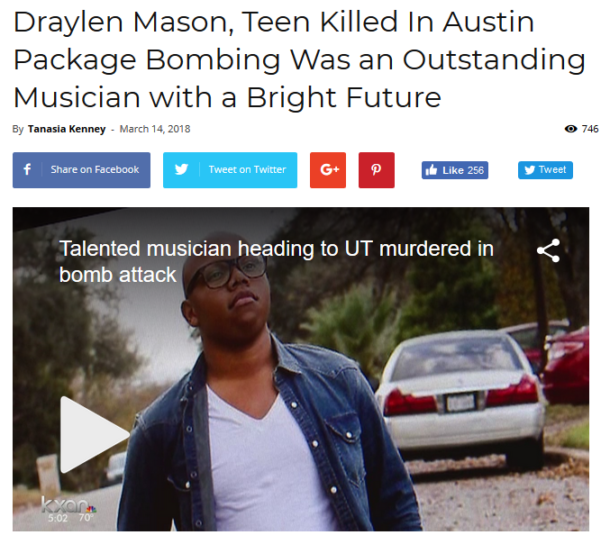
“The loss of a child with such conspicuous ambition, talent and determination is the cruelest kind of heartbreak,” the dean of UT Austin’s College of Fine Arts said of Draylen Mason.
(Atlanta Black Star, 3/14/18).
But playing by the rules to pursue the American Dream was not enough to protect House from police suspicion that he was a terrorist. As Effie Orfanides wrote in her Heavy story, “In fact, police initially wondered if House had been making a bomb and it detonated inside his home by accident.” Norrell Waynewood, who told Heavy he was House’s brother, accused local authorities of attempting to “frame” House.
Although he was just a 17-year-old boy, Draylen Mason was an accomplished bassist, an aspiring neurosurgeon, a karate instructor and an award-winning writer on racial profiling; he was also a Christian who played music for church services. As Atlanta Black Star (3/14/18) reported, Doug Dempster, dean of the College of Fine Arts at UT Austin, called Mason a “most remarkable talent in a most remarkable youth orchestra program,” the Austin Soundwaves, which teaches music for free to “artistically underserved children.” Dempster said Mason was devoted to helping younger, unsure students, and that his “gentle confidence seemed to come from a conviction that hard work and talent was going to work for him. It did.”
According to a search of the Nexis database, 270 stories mentioned Mark Conditt’s name in the days following his self-destruction. Of these, 86 mentioned the names of one or both of the people he killed—less than 1 in 3. Among the stories that didn’t mention either House or Mason’s name: the All Things Considered profile (3/21/18) that described Conditt as “shy, smart and thoughtful.”
____________________________________________
Research Assistance: Justin Anderson
DISCLAIMER: The statements, views and opinions expressed in pieces republished here are solely those of the authors and do not necessarily represent those of TMS. In accordance with title 17 U.S.C. section 107, this material is distributed without profit to those who have expressed a prior interest in receiving the included information for research and educational purposes. TMS has no affiliation whatsoever with the originator of this article nor is TMS endorsed or sponsored by the originator. “GO TO ORIGINAL” links are provided as a convenience to our readers and allow for verification of authenticity. However, as originating pages are often updated by their originating host sites, the versions posted may not match the versions our readers view when clicking the “GO TO ORIGINAL” links. This site contains copyrighted material the use of which has not always been specifically authorized by the copyright owner. We are making such material available in our efforts to advance understanding of environmental, political, human rights, economic, democracy, scientific, and social justice issues, etc. We believe this constitutes a ‘fair use’ of any such copyrighted material as provided for in section 107 of the US Copyright Law. In accordance with Title 17 U.S.C. Section 107, the material on this site is distributed without profit to those who have expressed a prior interest in receiving the included information for research and educational purposes. For more information go to: http://www.law.cornell.edu/uscode/17/107.shtml. If you wish to use copyrighted material from this site for purposes of your own that go beyond ‘fair use’, you must obtain permission from the copyright owner.
